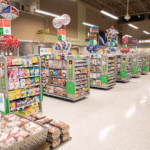“Fresh & Easy”? More like Costly & Failing. The British owner of the California-based, no-frills grocery store chain says it may be time to pack it in.
At a time when ALDI is taking the U.S. by storm, Fresh & Easy represented another foreign-owned small-format grocer when it arrived on U.S. shores five years ago. It expanded to about 200 stores in California, Nevada and Arizona. But now Tesco, the store’s parent company, says it’s conducting a “strategic review”, with “all options under consideration.” In other words, selling or shutting down the chain is the expected outcome. “It is now clear,” the company said in a news release, “that Fresh & Easy will not deliver acceptable shareholder returns on an appropriate timeframe in its current form.” A decision won’t come until the new year; in the meantime, “we are open for business as usual,” a store spokesman says.
Tesco poured $1.6 billion into the chain, but only a few locations actually turned a profit. The concept was to offer lower-priced, store brand products and prepared foods in a smaller setting. “You deserve wholesome food that doesn’t cost your whole paycheck,” the Fresh & Easy website says, in a thinly-veiled swipe at Whole Foods. The chain also touts its everyday low prices, which Walmart is famous for.
But many analysts said the chain was doomed from the start. “They tried to sell the consumer that they would have Whole Foods quality with Walmart pricing,” one analyst told the Oakland Tribune. “That never came to pass.” Fresh & Easy had the misfortune of launching right on the cusp of the global economic downturn, and then was accused of not doing enough to differentiate itself from Walmart, Whole Foods or other specialty retailers like Trader Joe’s. “The brilliance of a store like Trader Joe’s is it sells things that no one else sells,” another analyst told the Tribune. “Fresh & Easy sold some things that no one else had, but it wasn’t unusual enough to get the cult following that Trader Joe’s has.”
Its business model also wasn’t a favorite in union-dominated California. The stores have no cashiers, only self-checkout machines, which don’t work under contract. That had union leaders employing various tactics to undermine Fresh & Easy, according to supporters of the store (read: “Should Buy-Your-Own Beer Be Banned?”).
ALDI, which has more than a thousand stores in the U.S., has none in the states where Fresh & Easy operates. So analysts say it’s a natural candidate for possibly acquiring the chain. Like Fresh & Easy, ALDI touts its low prices and features a limited selection. But it doesn’t pretend to compete with the higher-end Whole Foods or its corporate cousin Trader Joe’s. “We sell only about 1,400 of the fastest-moving grocery items,” ALDI proclaims – not prepared foods or specialty items.
Yet, the Fresh & Easy-focused website Fresh & Easy Buzz reported months ago that ALDI was already planning on coming to California, regardless of what happened to Fresh & Easy. Citing sources, the website says ALDI plans to open about 100 stores on the west coast over the next two years. “ALDI has an interest in some Fresh & Easy stores and the distribution center,” the site reports. “However, we would be stunned were they to buy the entire Fresh & Easy operation.” Instead, Fresh & Easy Buzz predicts that “Tesco will have no choice but to sell Fresh & Easy off piecemeal.”
“I would be so disappointed if Fresh & Easy were to close,” one shopper told the Orange County Register. But another shopper was more resigned to the reality. Fresh & Easy has some good products, Debbie McGowan said, but it doesn’t have all of the groceries that her family needs. In a country where bigger stores are often considered better, a $1.6 billion bet to the contrary may have been one big, expensive mistake. Concluded McGowan, “Perhaps America just can’t handle shopping on such a small scale.”
Image source: Fresh & Easy













@Bubba Gump – There has been endless speculation in various news sites over the last few days on why Fresh and Easy aren’t more successful, most of it utter nonsense but you pretty much nailed it completely in one paragraph – many thanks.
The people in charge of this operation simply made too many dumb mistakes. They built stores in the ghetto then closed them, but still had to pay long leases. They give lots of money to charities even while not making a profit. They didn’t do enough market research before building 200 stores. They should have started slower and figured it out first. Take Las Vegas for example. Trader Joes has 3 stores and they built those over time. Fresh and Easy comes in and builds 20 stores all at once. There is simply not enough people who want this sort of store in the valley. For one thing we have huge successful Hispanic markets with about 1/3 of our population Hispanic. Did they really target Hispanics? Nope. You can’t even click a button to switch the machines to check out in Spanish and even if you could they don’t sell the stuff Hispanics want to buy. Yet they built stores in the middle of neighborhoods which according to the U.S. census are 90% Hispanic! Only an person who does not live here would make this idiotic mistake. The self check only was the dumbest idea from the start. What percentage of customers will never shop twice at a store that forces them to check out themselves. Does Trader Joes do this? Nope. Nobody does. Because unlike Fresh and Easy they actually talked to customers before attempting such a thing.